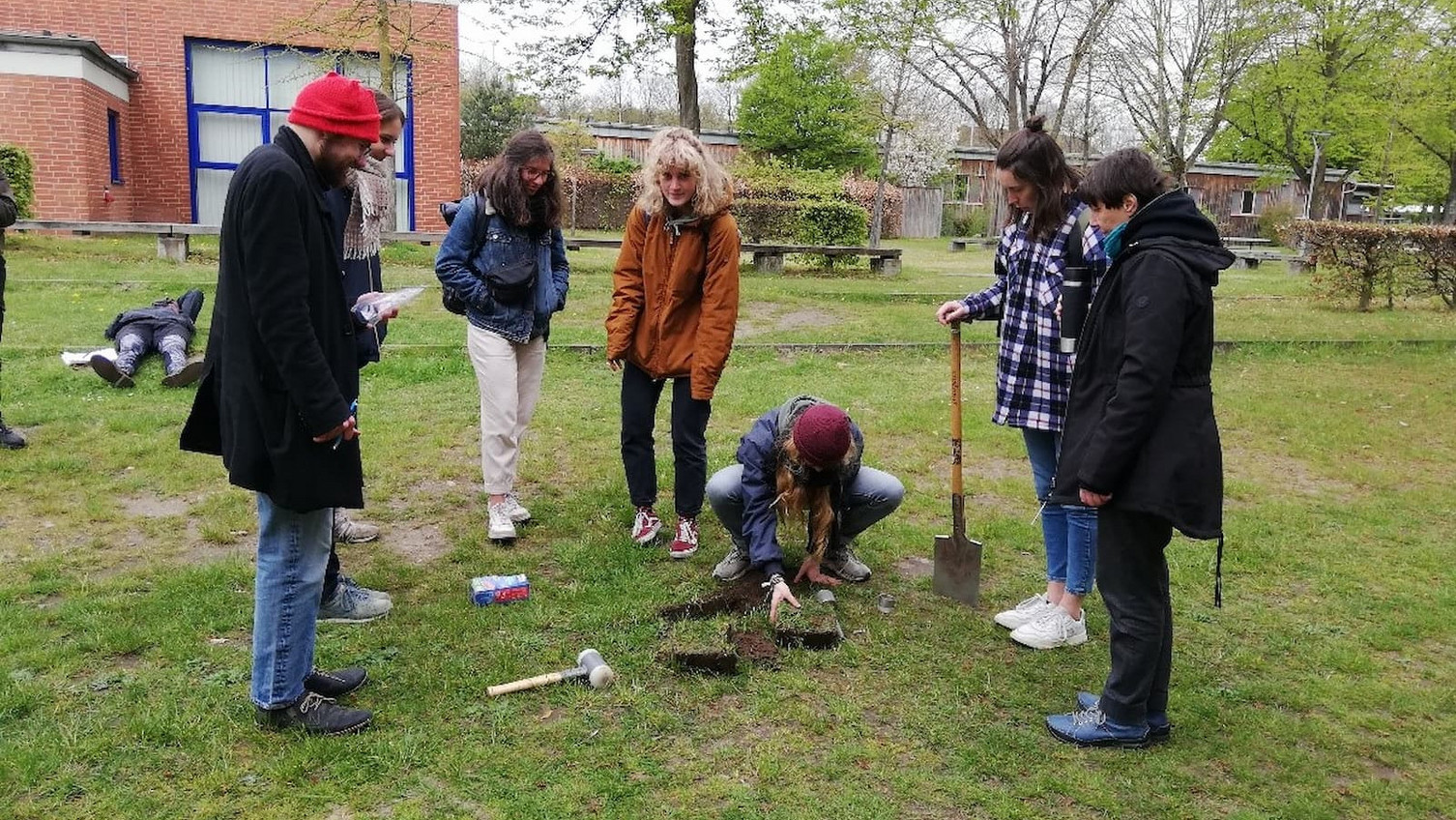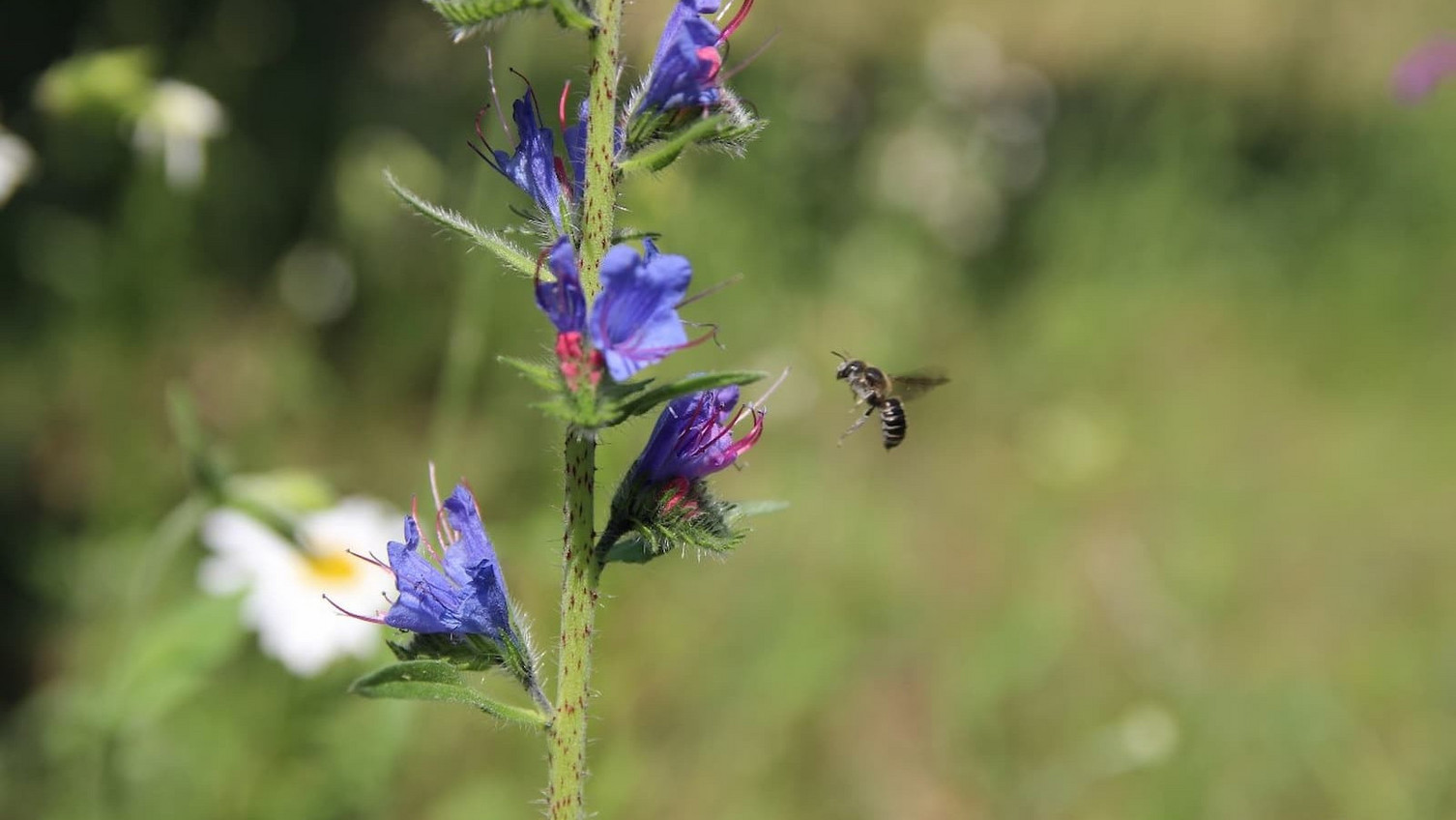Project seminar Restoring biodiversity on campus: Science and practice of restoring biodiversity go hand in hand
2023-09-10 In the seminar "Restoration of Biodiversity in Urban Settings - the Leuphana Campus" students can gain practical and scientific experience in urban restoration by restoring and measuring the biodiversity of species-rich meadows.
Mugwort, white campion, and yarrow blossom in the mini-insect meadow. A bumblebee drinks nectar from the blossoms of a viper's bugloss. Not far away, a hoverfly lands on a finger weed. Despite the small size of the flowering patch of lawn in front of Building 4, it hums and buzzes. "Urban spaces are an important arena of socio-ecological redevelopment. The Leuphana Campus holds great potential for restoring biodiversity and connecting people more closely to nature," explains Dr Manuel Pacheco Romero. Together with Prof Dr Vicky Temperton, Professor of Ecosystem Functions & Services, the environmental scientist teaches the seminar "Restoration of Biodiversity in Urban Settings - the Leuphana Campus".
The work in this course is project-oriented, working on specific aspects of the sustainability challenge of restoring biodiversity on campus. These challenges include considering options for landscaping that include increasing the proportion of native and biodiverse plant communities as well. In particular, recent research in ecology (Jandt et al. 2022) has highlighted that in Germany, for example, the plant species that have become rare over the past 100 years are mainly found in species-rich meadows and pastures whereas the ones that have gained in abundance live in forests. We have lost an enormous extent of our open grasslands (species-rich pastures and meadows) with industrialization of agriculture and land abandonment, and remaining grassland is often degraded and not ecologically in good shape. As such, a key focus of this course is to restore species-rich meadows (see arguments in Staude et al. 2023) by either creating them anew, or by reducing the mowing in already established lawns, as this is also known to boost plant biodiversity, if less so than making new meadows. Once a meadow has been restored, the insects tend to arrive especially if the seed mixture is a good one – although current weather extremes are hampering this recovery.
As part of the course, therefore, various meadow trial plots are being successively created on campus, which are either restored meadows (with soil preparation and sowing of ecologically-sophisticated species mixtures) or areas of reduced mowing (we still need to mow sometimes, though, otherwise bushes and trees would take over) and control plots that are mown very regularly. So far, in addition to the mini flower meadow, where a seed mix with native plants was spread, there are two areas that are mowed less frequently than the general campus green spaces. Over time, as successive cohorts of students take the course and work on assessing biodiversity change due to the restoration measures, more sites will be added. The goal of Prof. Vicky Temperton, as an experimental ecologist, is to end up with these restored sites forming a replicated experiment over the campus – thus allowing students and scientists to not only restore biodiversity and human-connectedness to nature, but also to do research in the transdisciplinary setting of the university campus, on how well the measures actually lead to more biodiversity, as well as providing resilient sites in climate change that store carbon belowground.
Four student groups are each working on one focus topic: vegetation, soil, insects and outreach. "We are interested in what plants and animals we find and how the soil conditions are. In the coming years, the seminar and experiments will be continued. We will then collect more data," says Manuel Pacheco Romero. The recurring seminar makes it possible to assess the long-term effects of socio-ecological restoration and biodiversity restoration over time, as the campus changes dynamically with the activities.
However, the results are not to remain in the seminar alone: "The successful implementation of restoration measures depends largely on public acceptance and communication. That is why we are conducting an information campaign about biodiversity values," explains Manuel Pacheco Romero. Results are published on Instagram and INaturalist, a social network and citizen science project, among others. Vicky Temperton adds: “Meadows change their aspect throughout the year, and can be beautiful in bloom, yellow and passive during the colder or hotter times of the year, and to some they may seem “messy” or less attractive than a garden-scape – yet they are masters in resilience, in providing a habitat for many species and they store carbon underground where it cannot be burned.”
The outreach work also aims to draw attention to the value of biodiversity, in particular to the key role that grassland species play in high biodiversity landscapes: "We humans no longer feel very dependent on nature. We need to value plants more again," says Lea Möller, a student assistant and tutor in the course in 2023. This year, a new collaboration with an external gardener, Gunther Böke (http://ladanum.info/), will enable the meadows and lawns to be mown with an insect- and mammal-friendly Brielmeier mower that also compacts the soil a lot less than conventional mowers.
During the seminar, a number of different actors involved in shaping the campus interact, including the Leuphana Biodiversity Initiative (AG), including Irmhild Brüggen (the sustainability officer of Leuphana), members of the Essbarer Campus and the Forest Garden (Waldgarten) initiatives, members of the presidential board, gardeners and other stakeholders on campus.
For students interested in being part of this ongoing love story with nature, the course is a “Räumliche Planung in der Praxis” module in the Spatial Sciences (Raumwissenschaften) minor, entitled "Restoration of Biodiversity in Urban Settings - the Leuphana Campus", and is offered every summer semester. Come join us!
References
Staude, Segar, Temperton et al. (2023) Prioritize grassland restoration to bend the curve of biodiversity loss. Restoration Ecology.
doi: 10.1111/rec.13931
Jandt [... ] Haider [... ] et al. (2022) More losses than gains during one century of plant biodiversity change in Germany.
Nature doi.org/10.1038/s41586-022-05320-w


